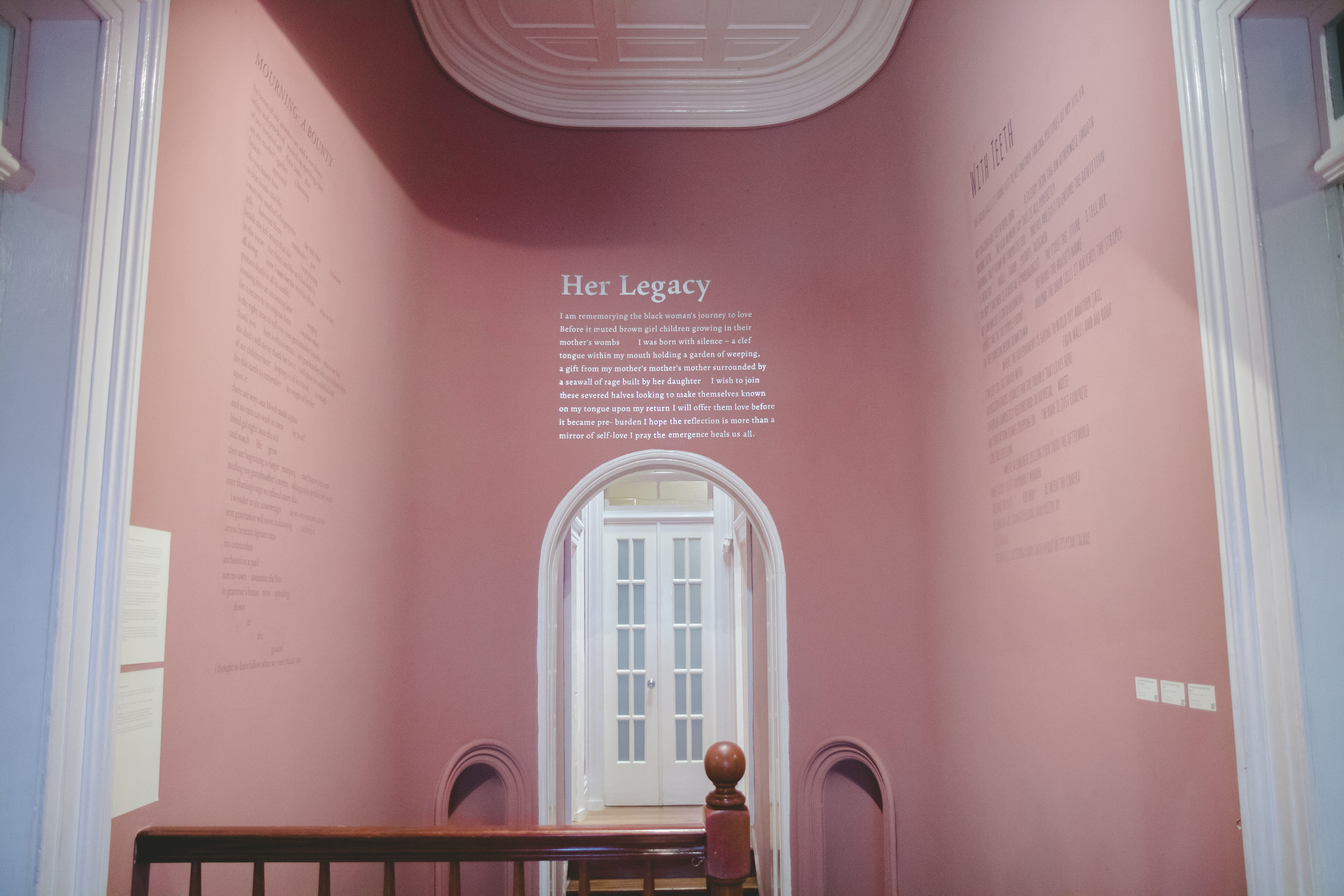By Kevanté A.C. Cash, NAGB Correspondent. At first glance, through a narrow lens, one could be offended by the works of emerging artist Cydne Coleby supported in the National Exhibition 9 (NE9) “The Fruit and The Seed”. Crafted with a “slight sense of narcissism”, interwoven with themes of erotic imagery, Coleby addresses the self – the God self, that is. She conducts a session of “soulversations” – moments in time allotted for self to do the work of loving and healing from past traumas and pains through her series “A God Called Self”.
Currently browsing: Stories
Tender Seedlings: Anina and A.L. Major Reflect on Pain and Love in the Bahamian Diaspora
By Natalie Willis. Art and language, be it in literature, poetry, or song, have perhaps always gone hand in hand. It makes sense of course, because really what we’re getting down to in artwork or in words is communication – often with one being used to describe or illustrate the other. It’s a happy collaboration, and so too was the collaboration between interdisciplinary artist Anina Major and her flesh-and-blood family A.L. Major. The two came together to produce Seedling (2018) for the NE9 “The Fruit and The Seed,” a work incorporating cohesively all manner of material – ceramic, wood, digital clocks, a newly sprouted dilly tree, and the words of poetry and phone calls overland and oversea. The work – part artistic laboratory experiment and part poetic becoming – gives us a way to think on the struggles of identity of the Bahamian emigre.
Something About Failure: Tessa Whitehead’s intimate questioning on success, failure, and what makes art work.
The Beauty and Charm of Colonialism: April Bey’s “Power Girl” Series
Push Out: Jodi Minnis and Ian Bethell-Bennett Investigate the Mythologies and Futures of Gentrification in Over-the-Hill
Essay Push Out: Jodi Minnis and Ian Bethell-Bennett Investigate the Mythologies and Futures of Gentrification in Over-the-Hill Natalie Willis ·
Mhudda: Jackson Burnside’s socially aware look at the struggles of the Bahamian “everyday”
When We Are Like the Trees
Stories When We Are Like the Trees Letitia Pratt · 18 February 2019 “You who are so-called illegal aliens must
The Island Repeated: Toni Alexia Roach’s Patterned Approach to Confronting the Past
By Natalie Willis. The land we live in feels like a repetition. We are a repetition of limestone rocks across shallow seas. We are repetitions of faces across families. We repeat the things we learn in school and church and wherever else – many times without critique, and, most disconcertingly, we repeat the same models of power–mainly paternalistic–from hundreds of years ago. This is at the heart of what Toni Alexia Roach gets to in her work for the “NE9: The Fruit and The Seed.” We look at the visual repetitions – palm tree after palm tree, and beach after beach – but we also see that these images are not symbolic of the place we live in, of the Caribbean, they are symbolic of the very idea of the Caribbean picturesque.
A Botanical of Grief: Yasmin Glinton and Charlotte Henay Connect with Ancestors’ Voices and Put Mother Tongue to Poetry
By Natalie Willis. In much of cultural studies, the Caribbean region has been discussed as a place where people feel an uneasy, tense tie to landscape due to our history of people being displaced here. Paradise or purgatory, whether these islands were viewed as restorative or a place of exile – and truthfully, we have had both stories ring true throughout time, it’s all in the branding. Tourist narratives aside, this space is a difficult one to feel truly close to, the landscape feels at once that it is ours and that it is without of our reach given the fact we are all “from elsewhere”, as Stuart Hall (the late Jamaican scholar and father of cultural studies) stated. Poetry in visual art can also be a difficult fit – is it language? Is it visual? Is it both? Problematising our ties to the land and the neat boxes that traditionalists might wish to shove the vast world of poetry into, are the unapologetic works of Yasmin Glinton and Charlotte Henay. “A Botanical of Grief” (2018), displayed in subtle silver script bearing powerful words of great weight, exists between – like so many of us in the Caribbean. The work is between voices: of the authors, of their ancestors, of poet and of artist, but it also exists in a liminal space physically as it spans the high walls of the stairwell of the 1860’s old bones that make up the Villa Doyle. Stairs are between places, and so are we as children of the Caribbean. We are between Africa and Europe, between India and China, we come from Arawaks, Tainos and Caribs with difficult access to those mother tongues – and most importantly, we are an amalgam of any and all combinations of these continents.
To Heal We Must Remember: Katrina Cartwright’s power figure uproots the past
By Letitia Pratt. It is a hopeful mission of the African diasporas to heal the ancestral pain that Black peoples have inherited. This healing will only come to us in the process of remembering. One of the primary ways to initiate this process is through the creation and consumption of art, which invites us to remember the past, take stock of the present, and come to terms with the complex histories that influence our current experiences as Black people. This process is especially needed for Black Bahamians, whose past traumas shape how we view ourselves. It is incumbent on our ability to tell truths about our past: we must recall times of slave rebellions, punishments, uprisings and revolts. We must remember the slaves that escaped the tyranny of Lord Rolle of Exuma – only to be recaptured and severely punished – and remember the tragedy of Poor Kate of Crooked Island who died from torture in the stocks for seventeen days. (The Morning Chronicle, 1929). It is these stories we need to remember. These are the stories that shaped our ancestors. These are the traumas we need to heal from. Katrina Cartwright’s Nkisi/Nkondi Figure: Prejudice is the Theory, Discrimination is the Practice, (2012) does just that: It forces us to remember, and it inspires us to heal.









